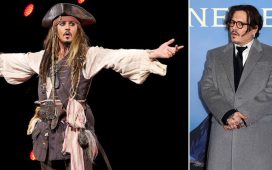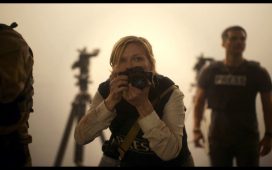If Midway really was the hot shit it thinks it is, we’d have something to talk about. But this spare-no-expense production about the most vital naval battle of WWII merely plasters the latest in digital effects over the same war-time movie tropes that Hollywood has been pedaling for decades. Director Roland Emmerich scored a box-office bonanza by showing the United States kicking alien ass in Independence Day. So why shouldn’t he take on a real battle with real heroes and a real enemy and show how the country made history and the world safe for cinematic jingoism?
Yes, Midway is a big swing at a big subject. After the Japanese bombing of Pearl Harbor, it became crucial — six months after that 1941 surprise attack — for the U.S. to win the battle with Japan over control of the Midway atoll, a victory that would turn the tide of the war in the Pacific. Emmerich gets the names, dates, and places right, but his film is a hollow shell stuffed with marshmallow. Hollywood basically made the same movie in 1976 with top stars — Charlton Heston, Henry Fonda, Robert Mitchum — hoping the noise of battle would drown out their risible dialogue.
It didn’t then and it doesn’t now. Wes Tooke’s screenplay never met a cliché it didn’t like. And it doesn’t matter how many name actors you throw into the mix. Look, it’s Woody Harrelson as Admiral Nimitz, the commander of the Pacific Fleet. And here’s Dennis Quaid as Vice Admiral ‘Bull’ Halsey, living up to his name. And there’s Aaron Eckhart as Lieutenant Colonel Jimmy Doolittle, who led a retaliatory raid on Tokyo for bombing Pearl Harbor. Each actor dutifully barks his lines without for a moment suggesting his character has more than one dimension.
There’s ample testosterone among the lesser luminaries as well. British actor Ed Skrein (Deadpool, Game of Thrones) struggles manfully, not just with the role of real-life rebel flyboy, Lieutenant Richard “Dick” Best, but with the jarring Jersey accent he uses to play him. Best even has a tough wife (Mandy Moore) and a cowboy attitude that won’t quit even when it puts him up in the face of Lieutenant Commander Wade McClusky (Luke Evans), who will later relent and say, “Men like Dick Best are the reason we’re gonna win this war.” Really? The bravery of these men is indisputable, what’s galling is the superficial manner in which they’re presented. Nick Jonas showing up just long enough as courageous sailor Bruno Gaido to get his name on the poster.
In other areas, Emmerich should be cut some slack, starting with his fair representation of the Japanese side. In a prologue set in 1937, we see Admiral Isoroku Yamamoto (Etsushi Toyokawa) trying to avoid the conflict he could see coming. He wasn’t the only one to see it. Patrick Wilson excels as U.S. intelligence officer Edwin T. Layton, who worked with a ragtag team of codebreakers to make sure our side would have the strategic advantage this time when the enemy struck.
You’d expect Emmerich to be in his wheelhouse staging the attacks from the air and sea. He even offers up the horrific sight of Japanese planes strafing Pearl Harbor as a prelude to the action on Midway. But repetition over two-and-a-half hours dulls the effect of what we are watching and whatever purpose there is in watching it. Emmerich can crack the whip on computer pixels like nobody’s business. But in sacrificing a reckoning on the human toll of war for cardboard characterization and showoff fx, he’s left an empty space where the soul of the film should be.














